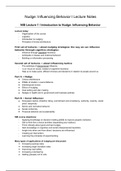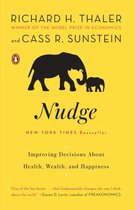Nudge: Influencing Behavior l Lecture Notes
NIB Lecture 1 l Introduction to Nudge: Influencing Behavior
Lecture today:
- Organization of the course
- Logistics
- Introduction to nudging
- Principles of choice architecture
First set of lectures → about nudging strategies: the way we can influence
behavior through cognitive strategies:
- Influence through cognitive heuristics
- Anticipate on biases and irrational behavior
- Building on information processing
Second set of lectures → about influencing tactics:
- The workings of interpersonal influence
- I.o.w: focus on social, instead of cognitive heuristics
- Help us to make quick, efficient choices and decisions in relation to people around us
Part A → Nudge
● Choice artchitecture
● Pitfalls of intuition / overconfidence
● Intertemporal choice
● Ethics of nudging
● Goal setting and plan making
● Nudges in health and in government and business policies
Part B → Social Influence:
● Persuasion tactics (Cialdini): liking, commitment and consistency, authority, scarcity, social
proof, reciprocity
● Norms and normative behavior
● Social conformity
● Prosocial behavior and sustainability
NIB course objectives:
- Applying knowledge on decision-making pitfalls to improve people’s behavior.
- Get to think like a choice architect (expanding your toolbox).
- Think critically about good and bad nudges.
- Gain knowledge on cognitive and social (interpersonal) heuristics.
- Insight into when and how others’ decisions are influenced.
- Creating an intervention.
- Learning the principles of experimenting.
Many types of applications of nudging are discussed:
➔ Increasing savings rates
➔ Increasing organ donation rates
➔ Improving road safety
➔ Increasing volunteering
➔ Getting (people) out to vote
,Introduction to nudging:
Nudge in the Netherlands: men find it very difficult to pee in the pot → fly in the pot for
men to focus their attention → one of the first examples in which something playful is
being used in order to make other people behave differently.
Nobel Prize in Economics in 2017 → Richard Thaler:
Nudge = ‘To push against gently, especially in order to gain attention or give a signal’ (Thaler &
Sunstein, 2008).
Nudge:
● Any aspect of the ‘choice architecture’ that alters people’s behavior in a predictable way
without forbidding options or dramatically changing economic incentives.
○ Password at a shop: ‘haveyoutriedthecarrotcake’ → unconsciously thinking
about the carrot cake → you are more likely to buy the carrot cake
● Nudges must be very cheap and easy to avoid (nudges are not mandates!)
● Nudges must be transparent
You can still take a donut, but you have to
do more effort for it →
Nudge at the Efteling → Holle Bolle
Gijs: keeping the park clean.
Nudge on the road for driving safely →
positive signals are something that we are
really ‘suckers’ of: we are ‘suckers’ for
flattery and we like to have positive signals
back: ‘smileys’ next to the road to make
people adjust their speed.
Incentives for making people take the stairs more:
- Economists: taxes on the escalator,
rewarding taking the stairs, discount on fitness when taking the stairs, etc.
- Policy makers: making posters and signs to inform people that taking the stairs is better for
them.
- Nudges: e.g. piano tiles on the stairs to make taking the stairs more fun.
➔ People don’t react the way traditional economics would predict: sometimes economics misses
things.
Assumptions of the standard economic model of consumer behavior:
1) People are rational
2) People act with full information → full external knowledge.
3) People have known preferences → we know what kind of preferences we have: no
matter what set of choices, we always know how to rank our choices from best to
worst: preferences are always stable, they don’t depend on the context.
4) People choose the best option available → people want to maximize utility: dictator
game (keeping the most money possible and not giving the other person
anything: full self interest), but, what we see, we want to see fairness and don’t
maximize our utility.
,Traditional economics:
Assumes humans are ‘optimal’ decision-making machines:
- Reasoning capacity is infinite
- Incentives can solve all problems
- Markets are perfectly efficient
- Every act is entirely selfish
Daniel Kahneman’s two systems of thinking (automatic versus effortful system):
System 1 System 2
Fast Slow
Unconscious Conscious
Parallel Serial
Associative Analytic
Low energy Consumes a lot of energy
‘Doer’ ‘Planner’
System 1 and 2:
● System 1: intuitive, fast, reactionary
● System 2: higher-level reasoning, cognitive, slower, resource-dependent.
Two systems of thinking:
- Interaction between both systems: both systems are active when we are awake.
- System 1 continuously and involuntarily generates suggestions for system 2
- If endorsed by system 2, impressions and intuitions turns into beliefs, and impulses into
voluntary action.
- This can work well, but it can also fail.
- The automatic system is especially prone to bias, in fact it uses bias to speed up
decision making.
- The reflective system might seem superior, but it is simply too slow to handle even a
fraction of the alternatives we are faced with every day.
➔ Driving: mostly unconsciously, but when we encounter a different situation while driving,
system 2 reacts.
Which system is used?
If people only decided based on their reflective, rational System 2, we wouldn’t need nudging
because people would simply consider what is best (utility, preferences) in a given moment.
● However, humans often decide with their intuitive fast System 1.
● Especially when we are:
○ Rushed
○ Tired
○ Not paying attention
➔ Question: if it is difficult to change behavior in a rational way, how can we then guide
people’s behavior?
Nudging principles:
,Libertarian paternalism:
- Thomas Paine
- Greg Johnson
Liberalism (Thomas Paine):
● The state should have respect for all citizens as free and equal human beings.
● The state should enable all citizens to develop and pursue their own conception of the good
life.
● Harm to others is the only basis for legitimate government intervention.
Paternalism, on the other hand (Greg Johnson):
● Paternalism goes further than the minimalist ‘no harm’ principle of liberalism and
argues that people should also be protected against harming themselves → e.g.
smoking ‘to death’
● The state should promote the interests of all citizens in living secure, health, wealthy and
happy lives.
● The state should interfere with people’s liberties if this generates desirable outcomes.
What nudges do, is to combine those → libertarian paternalism:
Libertarian paternalism or ‘nudging’ aims to improve people’s choices by being both:
● Libertarian: it does not block people’s choices and thus respects people’s (‘negative’ or
‘formal’) liberty
● Paternalistic: it makes people better and thus improves their well-being (health, wealth
and happiness)
Getting people to behave differently:
- It does not mean we should not use incentives, prohibition and informing people.
- But: we should also use subconscious nudges, peer-to-peer persuasion, and social marketing
among other things.
Principles of nudging:
1. Psychological ways of changing behavior
2. Focus on ‘guiding’ behavior
3. Instead of using incentives and information, use cues, frames and defaults → 25%
fat in yoghurt or 75% lean?
4. No force or prohibition, preserve freedom of choice.
5. Minimal costs.
6. Change of the choice architecture
Choice architecture:
● A choice architect designs the choice environment so as to encourage the chooser
to select a preferred choice → changing the choice environment of a buffet to put
the salad up front and the desserts further away.
● Maintain the chooser’s freedom to select other choices.
● Make desirable choices available and easier to choose.
● Make undesirable choices also available and harder to choose.
Everyone is a choice architect:
- Design for voters to choose candidates.
- Doctors describing alternative treatments.
- Form for employees to enroll in health plan.
- Parent to give options to child for different education.
, - Salespersons are all the time choice architects
- ‘Three hotel rooms still available’: design a particular environment in order to make
people take decisions in a particular, predictable way.
-
➔ ‘There is no such thing as a nudge-less choice, everything matters.’ (Richard Thaler)
When are nudges effective?
Behavioral Economics → assumes humans predictably deviate from ‘optimality’, for
example:
● Heuristics → ‘shortcuts’ that sometimes backfire.
● Overreaction to losses → people detest losing.
● Status quo → stick to what we have (inertia).
● Social norms → other-regarding preferences, fairness concerns, herd mentality.
● Impulsivity → we want rewards right now.
● Optimism and overconfidence → help us maintain a positive self-concept.
Predictable problems:
- Benefits now - costs later (should-want conflicts):
- Investment goods → doing too little
- Sinful goods → doing too much
- Difficulty of problem.
- Frequency.
- Feedback → only on the options we accept, not on the ones we reject.
- Outcome of choice is difficult to predict.
➔ Under these type of circumstances above, nudges become really effective.
Know how humans behave:
Humans:
● Need the stimulus to be consistent with desired action (stimulus response compatibility).
○ GO signal in red, Stroop task.
● Use the default (opt-in versus opt-out) → organ donation.
● Make errors (create forgiving systems).
● Need feedback → fitbit to improve health through feedback.
● Need easy comparisons (mapping, structure).
Example of a nudge:
- In the trains in the Netherlands they used to have prints of a library above them.
- Came out from two Dutch professors, at the moment when you see those library books, a
library comes into mind and you know that you behave more silently.
- Travelers spoke less long and less often when pictures of a library were presented on the
carriage of the train (Aarts & Dijksterhuis, 2003).
NIB Lecture 2 l Intuition, overconfidence and defaults
Lecture today:
- Pitfalls of intuition
- Overconfidence
- Dunning and Kruger effect (unskilled and unaware -
Kruger & Dunning, 1999) → knowledge clip
- Defaults






